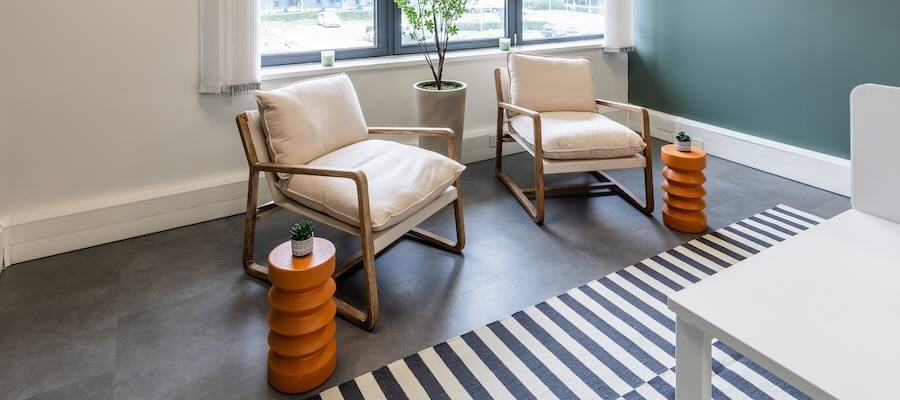Serviced Office v Standard Office
You have a successful business, it’s growing and you are taking on more staff. That inevitably means that you need more space. Before you start looking, it’s important to consider the different types of space available and decide which is most suited to you.

Key Differences at a Glance
Cost Structure:
Standard Office - Base rent, usually calculated per square foot or square metre, plus separate bills (e.g. utilities, internet, rates)
Serviced Office - All-inclusive monthly fee
Lease Term:
Standard Office - Long-term (typically 3-10 years)
Serviced Office - Flexible, often month-to-month
Initial Set-up:
Standard Office - Requires fit-out, furniture and full set-up
Serviced Office - Furnished and ready to move in and start working
Customisation:
Standard Office - Full control over design, decor and layout
Serviced Office - Limited customisation options
Facilities Management:
Standard Office - You are responsible for cleaning, maintenance and repairs
Serviced Office - managed by the provider and included in monthly fee
Flexibility:
Standard Office - Low. Fixed term and space
Serviced Office - High. Easy to upsize or downsize

The Standard Office: Your Blank Canvas
Whether you take on an entire building, a whole floor or just a room or two, the standard office space is just that. A space. A blank canvas to turn into a hive of activity for your team. It’s all yours to decide on the colour scheme, the décor, the furniture and the layout.
If that all sounds a bit too stressful, many office space owners provide a space planning and fit-out service. A professional can advise on the best way to arrange desks and workspaces to optimise the use of the floorspace. Ask if they are able to help you with the design of the internal layout so that it fits the way you operate and meets all your storage and communication needs.
When planning, you'll need to consider:
- Do you need a reception desk and seating area?
- How many meeting rooms are required?
- What about breakout areas or comfy seating for collaboration?
- Do you need a full kitchen or just a coffee machine?
- How much storage space is required?
- Will it be all open-plan or will there be some private offices?
The landlords may also be able to project manage the fit out itself so that you can carry on with your day to day work without having to allocate a member of staff to oversee the office refurbishment. That could be an extremely valuable service both in terms of money and sanity.

The Serviced Office: The All-in-One Solution
A serviced office takes all the hard work out of moving your business to a new space. All you need to do is choose the size of space you need and book a van. In fact, if furniture is included in your new office, you might not even need the van – just grab your laptop and start working.
Most providers will offer reception services, meeting rooms, electricity, broadband and kitchen facilities as a bare minimum. Others will include services such as office cleaning, insurance, car parking, showers or telephone answering. They are there to make your life easier and encourage your business to flourish so think carefully about how your company could benefit from having those aspects taken care of and all your costs rolled into one invoice.
Many serviced office providers give you the flexibility to grow, or downsize, without penalty. For example, they may charge on a desk-per-month basis, allowing you to change the number of desks you use very quickly, particularly if your landlord has a choice of different offices available. Perhaps you could start with 2 or 3 desks in a room and add a second room when the time is right.
Costs & Commitment
Your budget and financial forecasting will play a significant role in your decision.
- Standard Office Costs: The initial outlay is considerable. You'll have a security deposit, the first month's rent, legal fees, and the entire cost of the fit-out—from painting walls and laying carpets to buying every desk and chair. While the monthly rent might seem lower, you must also budget for business rates, utilities, internet, cleaning, and maintenance. This model offers long-term cost stability but requires significant upfront capital.
- Serviced Office Costs: Office rental is an operational expense rather than a capital expense. You pay one, all-inclusive monthly fee that covers rent, rates, utilities, and a host of other services. There are minimal upfront costs, often just a small, refundable deposit. While the per-desk cost might be higher than a traditional lease when calculated over many years, it offers unparalleled budget predictability and frees up capital.
Culture & Customisation
A standard office is uniquely yours. You can paint the walls in your brand colours, install custom signage, and design a space that is a physical representation of your company's culture and values. This can be a powerful tool for team building and giving clients a positive first impression if they visit your premises.
A serviced office, while professional and well-maintained, offers less scope for this level of branding. You are in a shared building, and your office space itself will likely have a neutral design. However, the community aspect of many serviced offices can be a benefit, offering networking opportunities with other businesses in the same premises.
Consider Both Options
If you still can’t decide which is for you, find a landlord that offers both options and talk to them about the pros and cons, visit them (or take a virtual tour if that is easier) and ask their advice. They speak to people like you all the time so they are in an excellent position to guide you to the right conclusion.
Final Checklist: Ask Yourself These Questions
- How much capital can I invest upfront? (Low = Serviced, High = Standard)
- How certain am I of my headcount in two to three years? (Uncertain = Serviced, Certain = Standard)
- How important is having a unique, branded space? (Very = Standard, Not very = Serviced)
- Do I have the time and resources to manage an office fit-out and ongoing maintenance? (No = Serviced, Yes = Standard)
